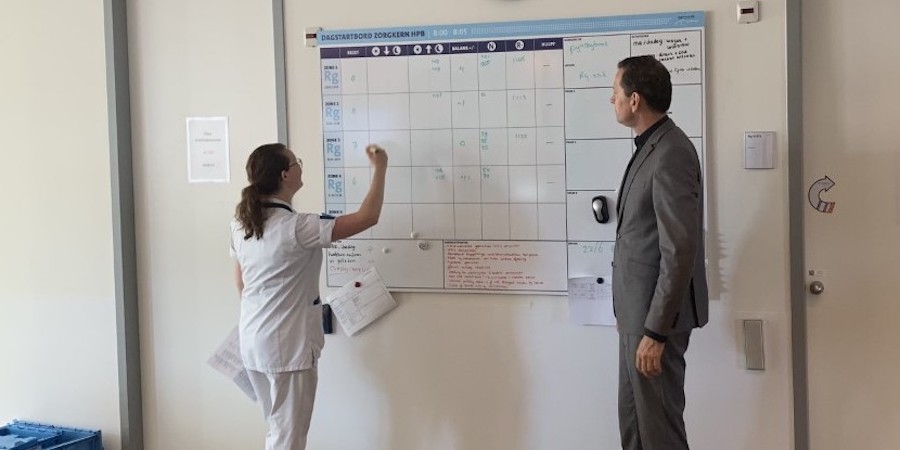
Leading the change
FEATURE – Our editor recently caught up with the director of the largest hospital in the Netherlands and asked him about the lean transformation he’s leading there.
Interviewee: Kjeld Aij, Director, Erasmus Medical Center – Rotterdam, The Netherlands
RP: What organization did you find when you took on the position of Director of this hospital? What were your first 100 days like, so to speak?
Kjeld Aij: I started two weeks before we received our first Covid patient. It was a hectic start, of course, but as soon as things stabilized a bit, I decided to take a close look at the current state of things at Erasmus Medical Center. Those first few weeks, I conducted around 150 interviews with staff members and constantly walked the gemba to really understand the situation. (It helps that I have been working in hospitals for 25 years.)
During my investigation, I discovered several things.
First of all, I realized that our people were exhausted because of the recent relocation (the medical center had different sites around the city that were combined and brought into a new building). As part of the reorganization, all kinds of teams were integrated but the fact that we hadn’t followed a proper redesign process meant that lots of people struggled through the transition. I found psychological safety to be lacking in several areas.
I also found that we do wonderful things on the medical side – we are a very innovative organization – but not on the business side, with no operational management in place. This meant we often struggled to stay on top of the work, to keep track of our activities, which means that we lost a lot of revenue opportunities. Another major problem for us is turnover. With the hospital expanding, the number of patients we treat went through the roof and stress ensued: between 2018 and 2020, nearly 35% of our nurses left the organization.
From a cultural standpoint, I observed that a lot of managers were locked in their offices and had no real understanding on what was going on at the gemba. On the shop floor, I noticed that people found it difficult to admit when something was wrong, for fear of being reprimanded. Furthermore, doctors and nurses collaborated effectively in the provision of care to patients, but not in the resolution of problems. In other words, we were not a learning organization.
From day one, I saw a lot of hard-working, enthusiastic people here at Erasmus MC, but also a lot of opportunities for improvement. That’s when lean came into the picture.
RP: What did you do to try and solve these problems?
KA: Aware that we had to change the way of our people think and create a system in which problem solving and continuous learning become our bread and butter, we engaged with Lean Management Instituut to get some help in introducing some operational management and get some stability in our processes. From the very beginning, therefore, standardization was one of our main focuses.
Together with LMI, we devised a strategy that entailed nine waves of training for selected leaders in the organization (the first cohort just completed their training). We understand it’s critical we change their mindset, so they become more present on the floor and help us to steer the ship, so to speak.
At Erasmus MC, people are very enthusiastic about lean (perhaps this speaks to the pragmatic, hard-working attitude of Rotterdammers). Even though they often want to jump to solutions, this is certainly fertile ground for a lean transformation.
RP: How do you select the people who take part in the training waves?
KA: The waves are targeting primarily middle management – in particular, nurses, HR advisors (we plan to train 33 of them), quality supervisors, and coordinators. I’d like top management to also take part in these development efforts, but we’ll need to wait a little longer because we have a few senior leaders who are about to retire.
After the summer, we want to devise a plan to further engage medical staff: they are already involved in A3 discussions, especially nurses, but we want to get doctors involved too. Luckily, they are beginning to ask questions about the improvements taking place in the hospital: for now, we’d rather make them curious than force them to take part in a training program.
We are already seeing commitment grow and it’s clear more and more people are internalizing lean, with an increased focused on patient needs. We continue to encourage managers to be more visible for their teams and to be coaches for them. We are seeing more visual management across the organization. Right now, we are focused on spreading the lean word and on changing behaviors. Then, we will finetune.
RP: What was the reasoning behind the reorganization and the combining of areas into bigger wards? What are the learnings there?
KA: The reasoning was capacity management. From that perspective, it made sense to go in that direction, even though at the beginning the change caused a bit of an identity crisis for some of our nurses. When we brought plastic, orthopedic, dermatology and traumatology surgery nurses into one team and one ward, many of them didn’t know “who they were” anymore. This is not a problem anymore (the work is largely the same) and collaboration across specialties now happens seamlessly.
RP: How do patients perceive the care they receive?
KA: Our NPS is actually high, at 8.9, but I suspect that has something to do with people’s expectations because we actually have so much improving to do!
RP: Can you give us an example of a process you are trying to improve?
KA: We still send our patients letters to remind them of their appointments. Because of the privacy legislation here in The Netherlands, however, we can’t mention the exact location and the date of the appointment on the letter. So, people also receive a message inviting them to look up the details of their appointment on a digital portal. It’s a cumbersome process, and the problem is compounded by the fact that many of our patients aren’t well-versed in the use of digital tools or don’t speak Dutch to begin with. As a result, we lose an estimated 20% of patients! Those who do log in often find out about their appointment too late and when they need to call us to postpone, they struggle to reach us. So we have a lot of no-shows. The worst part? As per the law, people who don’t show up are sent a €45 fine! As you can imagine, complaints always ensue. Surely, there is a better way to do this. I am happy to report that one of the leaders going through lean training is tackling this issue.
RP: What does a learning organization look like in your eyes and what are you doing to turn Erasmus MC into one?
KA: To me, a learning organization is an environment in which people aren’t afraid to flag up problems, as it is from problems that learning stems. I want to make Erasmus MC a safe environment for every worker. Our hospital has a traditional hierarchical structure, which means that people are often still afraid to make mistakes or speak up. We are trying to knock down those walls.
This, of course, depends largely on the management team. Can they ensure this is a safe environment for employees? I know that a transformation can be overwhelming and that it’s common to not know where to start. So, at the moment, we are asking managers what the top 3 problems their people are experiencing are and what they think we can do to solve them? This is how we hope to get the learning going.
RP: From an organizational standpoint, can you tell me more about the problems Erasmus MC is experiencing and how you think lean can help tackle them?
KA: Finding the right talent and retaining it is certainly one of them. We can’t accept people leaving us after two or three years, considering the investment we make to develop their skills. Lean can help with this, of course: it will turn Erasmus MC into a better workplace, it will make it easy for people to do their work, and it will ensure they are constantly learning.
Another issue, in my opinion, is the healthcare system we have in this country, which puts hospitals in competition with one another. This is ultimately not good for the patient. We need to move towards a model based a regional network of collaborating hospitals. We need to find better ways of working together and sharing lean successes can help us to get there. We have already begun to facilitate such conversations with other organizations in the area, and even helping them to run some lean experiments of their own.
RP: What is your role as a leader in supporting this transformation?
KA: I see myself as a facilitator. My responsibility is to create a context in which the seeds we plant have the highest possible chance of growing.
I am making it very clear that this is not a “project” and this way of thinking is here to stay. I have a four-year tenure here, so I am constantly asking myself what I can do in this time to ensure that when I leave the lean journey continues. I know I must ensure lean culture becomes part of the DNA of this hospital, so that everything we do is about the patient. It’s clear to me that the solution is not some system, but people: we must keep their enthusiasm going.
I also need to lead by example, of course. How can I expect people to embrace lean if I don’t? That’s why I spend as much time as I can on the gemba, asking questions and supporting people in their learning. As a leader, it’s important to show your face: as nerve-wrecking as it can be at first to have the boss around, this is ultimately what changes minds.
We have a long way to go, and a lot to learn (I have been working with lean for ten years and I still learn new stuff every day). But I am confident in our approach: taking small steps and solving small problems will eventually make a difference.
THE INTERVIEWEE

Read more


ARTICLE - What is lean? We all like to think that we know. This personal story reminds us all of how elusive the methodology can be, and how determined a practitioner has to be to fully grasp it.


CASE STUDY – When it had to develop a production process for a new product from scratch, this Dutch company leveraged lean tools and practices. And the results were impressive.


INTERVIEW – At the recent European Lean Healthcare Transformation Summit, we sat down with Helen Zak for a few minutes to discuss the state of change in the healthcare sector.


FEATURE – Collaboration with suppliers, rather than a merely transactional relationship, has to power to transform a company’s operations, fostering innovation and building resilience.

